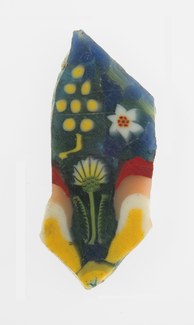Fragment of Floral Inlay

Glass production flourished during the Ptolemies’s reign: the Macedonian kings introduced to Egypt new glass vessels and glass decorations whose shapes, motifs, and techniques originated in the ancient regions of the Mediterranean. The fragments on display, in their wide range of forms and colors, illustrate the infinite variants that could easily be produced by adopting the Greek glass-making technique known as core-forming, which allowed serial reproduction of the same motif almost indefinitely. The glassmaker began with a group of thin molten-glass rods of different colors. He combined them into a cane, arranging the various rods next to each other to create a design that would be visible when a cross-section of the cane was cut. The cane was then pulled and stretched, reducing the design to a small scale, and cut in slices. Each slice formed one of an identical series of glass plaques that were primarily used as inlays for furniture, including beds and boxes that were employed both in burials and in temples.
E. Marianne Stern, Birgit Schlick-Nolte. Early Glass of the Ancient World: 1600 B.C. - A.D. 50. Ernesto Wolf Collection. Verlag Gerd Hatje, Ostfildern 1994.